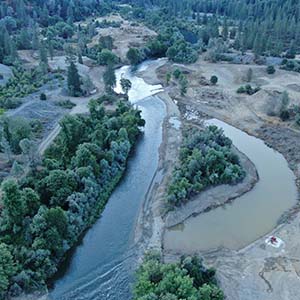Trinity River Restoration
Salmon and steelhead evolved to overcome natural threats, but unnatural threats including dams, mining, and human land use have caused steep declines in the species. These human impacts drastically altered the watershed, reducing fish habitat and changing the dynamic nature of the river. Decades of extensive research evaluated the impacts of dam operations on fish and wildlife. From these studies, the 2000 Record of Decision (ROD) management plan was developed to restore fish populations to pre-dam levels.
Restoration is an important tool humans can use to restore salmon populations and overall river health. On the Trinity River, these efforts include:
Explore The Trinity River Restoration
Variable Flow Releases: restoration flow releases aim to mimic natural snowmelt patterns and help restore dynamic river processes. Flow releases are collaborative and are based on inflow into Trinity Lake from the upper Trinity River.


Channel Rehabilitation Projects: in-channel and floodplain restoration aims to restore habitat for juvenile and adult salmon, and create a more naturally diverse, complex river system.
Gravel Augmentation: spawning-sized gravels have been added periodically to the Trinity River immediately downstream of Lewiston Dam to replicate sediment transport from the upper Trinity River. Fish use these gravels to build their nests.


Watershed Activities: watershed-wide restoration spans further than the mainstem Trinity River to include riparian habitat improvements, fish passage improvements, and tributary restoration.
Science and Adaptive Management: as the river changes – so does river science. The river is a complex system that is not fully understood. Natural resource management evolves as scientific knowledge advances.
Trinity River Restoration Program (TRRP)
The Trinity River Restoration Program (TRRP) works collaboratively to restore vital habitat and provide salmon a better chance to survive the freshwater portion of their lifecycle below Lewiston Dam. TRRP implements management strategies that evolve as science and technology advance. The TRRP upholds the 2000 Record of Decision by executing mandated restorative actions on the Trinity River and is overseen by the Trinity Management Council, consisting of 8 partner groups.
For more information on river restoration on the Trinity, please visit:
http://www.trrp.net/ or call (530) 623-1800.

